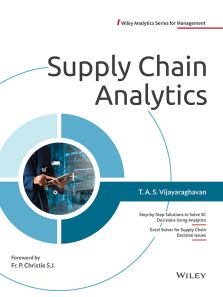Supply Chain Analytics
ISBN: 9789354243431
552 pages
Publication Year: 2021
For more information write to us at: acadmktg@wiley.com

Description
Supply Chain Analytics is a structured collation of important analytical tools and techniques that specifically addresses critical decision areas in warehousing, inventory, and transportation in supply chain management, which are mostly available in some technical academic papers and proceedings of conferences and so will be very helpful to find them all in one book. This book explains various practical application methods in a lucid manner so that any student with basic understanding of Decision Sciences will be able to understand popular analytical tools and techniques useful in supply chain management areas.
Section I Overview of Logistics and Supply Chain Management
Chapter 1 Overview of Logistics and Supply Chain Management
1.1 Introduction
1.2 SCM and Competitive Advantage
1.3 Driving Forces in Business and SCM
1.4 Overview of Logistics Management
1.5 Overview of Supply Chain Management
1.6 Supply Chain Analytics
Section II Overview of Optimization Methods
Chapter 2 Overview of Optimization Methods
2.1 Introduction and Historical Perspective
2.2 Constrained Optimization Models
2.3 Assumptions of an LPP
2.4 General Form of LPP
2.5 Graphical Solution to Furniture Problem
2.6 Simplex Method
2.7 A Few Examples of Formulation of LPP
2.8 Transportation Problem
2.9 Assignment Problem
Section III Facilities Location and Warehousing Decisions
Chapter 3 Facility Locations and Discrete Location Models
3.1 Introduction
3.2 Single Facility Location Problems
3.3 Multiple Facility Location Problems
3.4 Mathematical Formulations of Popular Location Problems
3.5 Conclusion
Chapter 4 Facility Locations through Heuristic and Other Approaches
4.1 Introduction
4.2 Heuristic Methods
4.3 P-Median Solution for Example 4.1
4.4 Greedy Drop Heuristic for Capacitated Depots with Fixed Costs
4.5 Capacitated Fixed Charge Model Solution for Example 4.1
4.6 Mathematical Programming Approach to Facilities Location Problems
4.7 Baumol and Wolfe Method
4.8 Spatial Interaction Models
Chapter 5 Tactical and Operational Decisions in Warehousing
5.1 Introduction and Space Determination in Warehouse Planning
5.2 Warehouse Operations and Layout Decisions
5.3 Handling Decisions
5.4 Layout Configuration Decisions
Section IV Inventory Decisions
Chapter 6 Inventory Concepts, Costs and Basic Models
6.1 Introduction
6.2 Reasons for Keeping Inventory
6.3 Reasons against Keeping Inventory
6.4 ABC Analysis and Pareto Analysis (80-20 Rule)
6.5 Managing Inventories and Inventory-Carrying Costs
6.6 Single-Period Inventory Models (Newsvendor Model)
6.7 Optimal Stock Level in Newsvendor Models (for Continuous Distributions)
6.8 Repetitive Order Quantities (Pull Models)
6.9 Production Order Quantities (POQ) Models
6.10 Quantity Discount EOQ Models
Chapter 7 Inventory under Uncertainty and Service Levels
7.1 Introduction
7.2 Factors Affecting Safety Inventory
7.3 Understanding Demand Uncertainty
7.4 Service Levels and Product Availability Measures
7.5 Average Inventory Level
7.6 Estimation of Unit Service Level or Fill Rate
7.7 Impact of Lead Time Uncertainty on Inventory Decisions
7.8 Backorder Case
7.9 Lost Sales Case
Chapter 8 Joint Replenishment and Lot Sizing in Inventory Decisions
8.1 Introduction and Inventory Investment Decisions
8.2 Lot Sizing Inventory Management Interpolation Technique
8.3 Lagrangian Multipliers
8.4 Joint Replenishment of Multiple Items
8.5 Lot-Sizing Techniques (Dynamic Lot Sizing)
8.6 Multi-Echelon Inventory Decisions
8.7 Risk Pooling or Centralization of Inventories
Section V Transportation Decisions
V Transportation Decisions
Chapter 9 Trade-Off Decisions and Network Models in Transportation
9.1 Introduction
9.2 Basic Trade-Offs in Transport Decisions
9.3 Transport Service Selection
9.4 Operational Planning in Transportation
9.5 Network Models
9.6 Minimal Spanning Tree
9.7 Shortest Path Algorithms
9.8 Bellman–Ford Algorithm ( for Negative Link Lengths)
9.9 Floyd-Warshall Algorithm
9.10 Maximum Flow Model
Chapter 10 Routing Using the Traveling Salesman Problem Algorithms in Transportation
10.1 Introduction
10.2 Characteristics of Routing and Scheduling Problems
10.3 The Traveling Salesman Problem
10.4 Heuristics for Solving a TSP
10.5 Construction Heuristics
10.6 k-Opt Tour Improvement Method
Chapter 11 Routing and Scheduling Problems and Methods
11.1 Introduction
11.2 Vehicle Routing Problems
11.3 Branch and Bound Method for Solving Routing Problems
11.4 Clarke–Wright Savings Algorithm for Solving Routing Problems
11.5 Sweep Heuristic for Solving VRPs
11.6 Generalized Assignment Method
11.7 Vehicle Scheduling Methods
11.8 Deficit Function Approach to Vehicle Scheduling
Section VI Multicriteria Decision Making
Chapter 12 Multi-Criteria Decision Making
12.1 Introduction
12.2 Multiple-Attribute Utility Theory
12.3 Terminologies in MADM or MCDM Methods
12.4 Analytic Hierarchy Process
12.5 Technique for Order of Preference by Similarity to Ideal Solution (TOPSIS)
12.6 Basics of Fuzzy Logic
12.7 Fuzzy Analytic Hierarchy Process
12.8 Fuzzy TOPSIS
Summary
Exercises
Bibliography
Index

